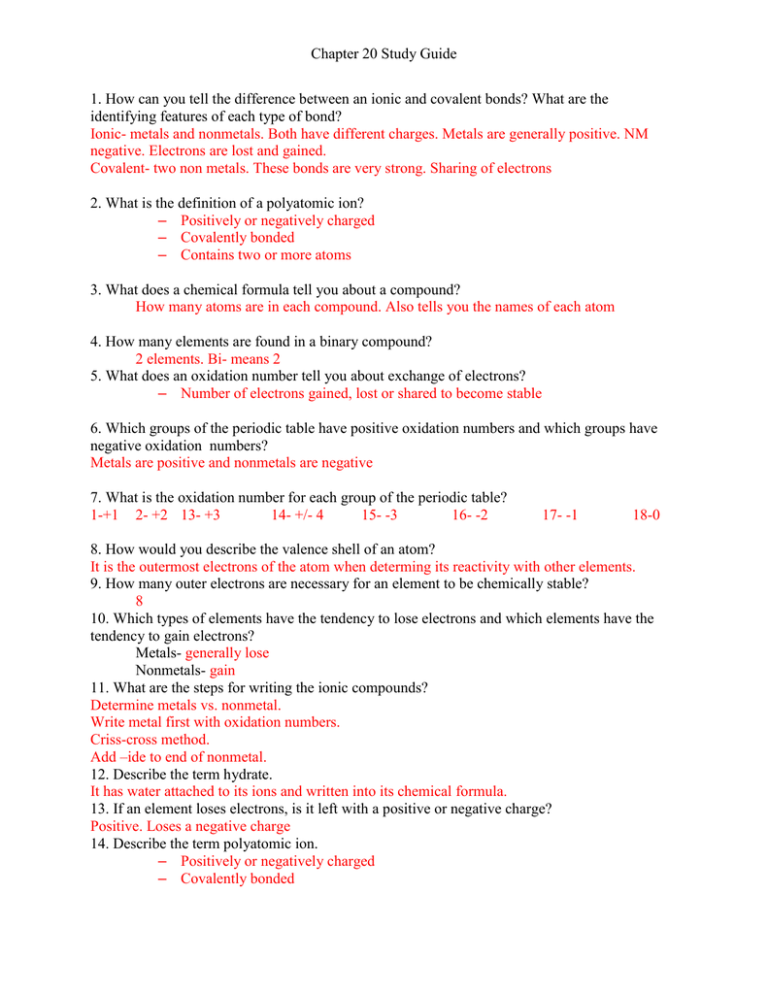Chapter 20 Study Guide 1. How can you tell the difference between
advertisement

Chapter 20 Study Guide 1. How can you tell the difference between an ionic and covalent bonds? What are the identifying features of each type of bond? Ionic- metals and nonmetals. Both have different charges. Metals are generally positive. NM negative. Electrons are lost and gained. Covalent- two non metals. These bonds are very strong. Sharing of electrons 2. What is the definition of a polyatomic ion? – Positively or negatively charged – Covalently bonded – Contains two or more atoms 3. What does a chemical formula tell you about a compound? How many atoms are in each compound. Also tells you the names of each atom 4. How many elements are found in a binary compound? 2 elements. Bi- means 2 5. What does an oxidation number tell you about exchange of electrons? – Number of electrons gained, lost or shared to become stable 6. Which groups of the periodic table have positive oxidation numbers and which groups have negative oxidation numbers? Metals are positive and nonmetals are negative 7. What is the oxidation number for each group of the periodic table? 1-+1 2- +2 13- +3 14- +/- 4 15- -3 16- -2 17- -1 18-0 8. How would you describe the valence shell of an atom? It is the outermost electrons of the atom when determing its reactivity with other elements. 9. How many outer electrons are necessary for an element to be chemically stable? 8 10. Which types of elements have the tendency to lose electrons and which elements have the tendency to gain electrons? Metals- generally lose Nonmetals- gain 11. What are the steps for writing the ionic compounds? Determine metals vs. nonmetal. Write metal first with oxidation numbers. Criss-cross method. Add –ide to end of nonmetal. 12. Describe the term hydrate. It has water attached to its ions and written into its chemical formula. 13. If an element loses electrons, is it left with a positive or negative charge? Positive. Loses a negative charge 14. Describe the term polyatomic ion. – Positively or negatively charged – Covalently bonded Chapter 20 Study Guide – Contains two or more atoms Elements that are covalently bonded that have a positive or negative charge that can bind with other elemetns. 15. List the eight examples of polyatomic ions in section 3 of chapter 20. Provide the ionic charge for each polyatomic ion. Charge Name Formula 1+ Ammonium NH₄ 1- Acetate Chlorate Hydroxide Nitrate C₂H₃O₂ ClO₃ OH NO₃ 2- Carbonate Sulfate CO₃ SO₄ 3– Phosphate PO₄ 16. Which group of the periodic table are the least likely to react with other elements? Nobel gases-18 17. What are the prefixes used for the numbers 1 – 8 when naming covalent compounds? Mono, di, tri, tetra, penta,hexa, hepta, octa 18. Name 3 elements that readily lose electrons, 3 elements that usually gain electrons, and 2 elements that usually share electrons. Li, Na, K lose N, O, F gain C and Si share 19. What is the difference between cations and anions? • Cation – Metals – Lose electrons – Carry a (+) oxidation number • Anion – Nonmetals – Gain electrons – Carry a (-) oxidation number 20. Use the criss-cross method to write the chemical formulas for: Chapter 20 Study Guide Lithium fluoride: __LiF____ Potassium phosphide:_K3P__ Sodium Oxide: ___Na2O___ Beryllium Nitiride: _Be3N2__ Magnesium Flouride: __MgF2____ 21. Be able to write the chemical name for the following compounds. lithium fluoride ____Lithium Fluoride________________________ sodium oxide_______Na2O______________ dinitrogen pentoxide ______N2O5_______________________ beryllium nitride __________Be3N2________________________ silicon tetrachloride ________SiCl4______________________ 22. Write the correct formulas for the following polyatomic ions Be sure to use the criss-cross method to write subscripts for each ion sodium nitrate _______NaNO3_____________________________ ammonium phosphate_____(NH4)3PO4_______________________ calcium phosphate _____Ca3(PO4)2___________________________



